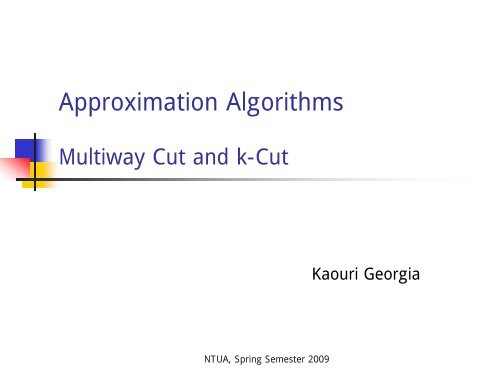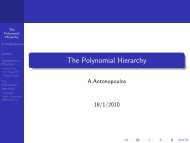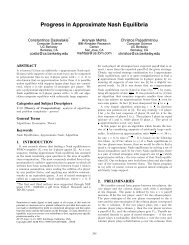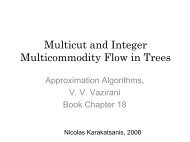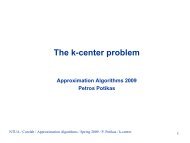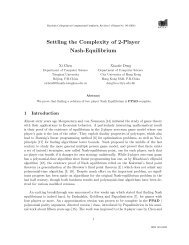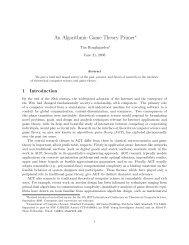Approximation Algorithms Multiway Cut and k-Cut - Corelab
Approximation Algorithms Multiway Cut and k-Cut - Corelab
Approximation Algorithms Multiway Cut and k-Cut - Corelab
Create successful ePaper yourself
Turn your PDF publications into a flip-book with our unique Google optimized e-Paper software.
<strong>Approximation</strong> <strong>Algorithms</strong><br />
<strong>Multiway</strong> <strong>Cut</strong> <strong>and</strong> k-<strong>Cut</strong><br />
Kaouri Georgia<br />
NTUA, Spring Semester 2009
Definitions<br />
• A cut on an undirected, connected graph G=(V,E) with weights<br />
to edges w: ER + , is defined by a partition of E into two sets, V’<br />
<strong>and</strong> E-V’, <strong>and</strong> consists of all the edges that have one endpoint in<br />
each partition.<br />
• Given terminals s,t in G, the cut defined by a partition that<br />
separates s from t is called an s-t cut.<br />
• <strong>Multiway</strong> cut: Given a set of terminals S={s 1 ,s 2 ,…,s k }, a multiway<br />
cut is a set of edges whose removal separates all terminals from<br />
each other.<br />
• k-cut: A set of edges whose removal leaves k connected<br />
components is a k-cut.<br />
• We are interested in the minimum weight version of these<br />
problems.<br />
NTUA, Spring Semester 2009 2/9
2-2/k approximation algorithm for<br />
minimum weight <strong>Multiway</strong> cut<br />
• Algorithm:<br />
• For each i=1,2,…,k, compute a minimum weight isolating cut for s i , say C i .<br />
• Output the union of these cuts, discarding the heaviest.<br />
• The above algorithm is 2-2/k approximative.<br />
• Let A be an optimal multiway cut in G. A is composed by k subsets, say<br />
A 1<br />
, A 2<br />
,…,A k<br />
, where A i<br />
is the cut that separates the component<br />
containing s i<br />
from the rest of the graph.<br />
• Each edge of A has its two endpoints in two A i<br />
s. Therefore<br />
Σ i=1k<br />
w(A i<br />
)=2w(A).<br />
• A i<br />
is an isolating cut for s i<br />
, but C i<br />
is the minimum, so w(C i<br />
)≤w(A i )<br />
• We discard the heaviest of the cuts C i , therefore<br />
w(C) ≤(1-1/k)Σ i=1k w(C i ). Hence:<br />
w(C) ≤ (1-1/k) Σ i=1<br />
k<br />
w(C i ) ≤ (1-1/k) Σ i=1<br />
k<br />
w(A i ) = 2(1-1/k) w(A)<br />
NTUA, Spring Semester 2009 3/9
Tight example<br />
• Consider a graph with 2k vertices, k of which form a<br />
k-cycle with edge weight equal to 1 <strong>and</strong> k terminals,<br />
each one connected to one of the vertices of the<br />
cycle with edges of weight 2-ε for a small ε>0.<br />
• The algorithm computes a solution of weight<br />
(k-1)(2-ε), while the optimal multiway cut has weight<br />
k.<br />
NTUA, Spring Semester 2009 4/9
Construction of a Gomory-Hu tree<br />
• Consider a tree T with one node, the set S 0 =V<br />
• Select a set S i , |S i |≥2 <strong>and</strong> select 2 vertices u,v of S i .<br />
• Compute a minimum u-v cut in G’, where G’ is the graph<br />
obtained by G <strong>and</strong> collapsing each subtree of S i into a single<br />
supernode. We compute the minimum cut between u <strong>and</strong> v in<br />
the new graph <strong>and</strong> obtain a partition Vn containing u <strong>and</strong> V 2<br />
containing v.<br />
• Graph T is modified by breaking S i into two sets S i1 =S i IV 1 <strong>and</strong><br />
S i2 =S i IV 2 . We add an edge between them with cost the cost<br />
just calculated.<br />
• We connect a subtree of T to S i1 if its supernode was in the<br />
same partition as u in the minimum cut, otherwise we connect it<br />
to S i2 .<br />
NTUA, Spring Semester 2009 5/9
Properties of a Gomory-Hu tree<br />
• For each pair of vertices u,v in V, the weight of a minimum u-v<br />
cut in G is the same as that in T<br />
• For each edge e in T, w’(e) is the weight of the cut associated<br />
with e in G.<br />
• Lemma: Let S be the union of cuts in G associated with l edges<br />
of T. Then, the removal of S from G leaves the graph with at<br />
least l+1 components.<br />
• Let V 1 ,V 2 ,…,V l+1 be the connected components which are left in<br />
T after removing l edges. For any u in V i <strong>and</strong> v in V j , we must<br />
have removed some edge in T that disconnects u <strong>and</strong> v. A cut is<br />
associated with this edge in G, which must disconnect u <strong>and</strong> v<br />
in G as well. Thus removing l edges in T, results in at least l+1<br />
connected components in G.<br />
NTUA, Spring Semester 2009 6/9
(2-2/k) approximation algorithm<br />
• Compute a Gomory-Hu tree T in G<br />
• Output the union C of the k-1 lightest cuts of the n-1 cuts associated<br />
with edges of T in G<br />
• If more than k components are created, throw back some edges until there<br />
are k components.<br />
• Let A be an optimal k-cut in G. As before, let the cuts V 1<br />
,V 2<br />
,…,V k+1<br />
be<br />
the k components formed by removing A from G <strong>and</strong> A i<br />
the cut<br />
separating V i<br />
from the rest of the graph <strong>and</strong> Σ i=1k<br />
w(A i<br />
)=2w(A).<br />
• Assume A k<br />
is the heaviest cut.<br />
• Modify T by shrinking vertices corresponding to each V i<br />
into a<br />
supernode <strong>and</strong> remove edges until the graph becomes a tree T’.<br />
• Root T’ at the supernode of V k<br />
. Consider the edge (u i<br />
,v i<br />
) connecting a<br />
supernode V i<br />
with its parent. These edges belonged in T, therefore<br />
w’(u i<br />
,v i<br />
)≤w(A i<br />
). Thus<br />
Σ i=1<br />
k-1<br />
w’(u i ,v i<br />
)≤Σ i=1<br />
k-1<br />
w(A i ) ≤ 2(1-1/k) w(A)<br />
NTUA, Spring Semester 2009 7/9
Tight Example<br />
• Similar as in multiway cut.<br />
• 2k vertices k of which form a cycle with edge costs<br />
equal to 1 <strong>and</strong> k distant nodes (they are no longer<br />
called terminals) connected with one node of the<br />
cycle with an edge with cost 2-ε.<br />
• Using the Gomory-Hu algorithm a solution with cost<br />
(k-1)(2-ε), whereas the optimal algorithm picks all<br />
edges with cost 1, i.e. te cost is k.<br />
NTUA, Spring Semester 2009 8/9
Thank you!<br />
NTUA, Spring Semester 2009 9/9


